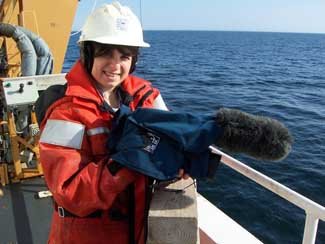The algae that bloom in the spring...tra la
May 22nd: 11:00 PM EDT
I’m just a few hours away from heading to Nome, AK from Newark, NJ. It turns out that the Healy is closer to Nome than anticipated, so I may not have to fly to Gambell to meet the helicopter. I won’t know until I get to Nome, however. It makes for a dynamic start to my adventure.
The Healy’s last posted location was Lat 64.3714 Long -168.663. That means the ship is north of St. Lawrence Island and well into the northern Bering Sea. Judging by the posted weather reports, the winds have settled down a bit. In early May, Healy faced 42-knot winds. You’d feel that wind hit your face at about 50 miles per hour. Today’s winds blew at a mere 8.6 knots.
is north of St. Lawrence Island and well into the northern Bering Sea. Judging by the posted weather reports, the winds have settled down a bit. In early May, Healy faced 42-knot winds. You’d feel that wind hit your face at about 50 miles per hour. Today’s winds blew at a mere 8.6 knots.
The weather in Nome is predicted to be warm in the next few days. The highs will be in around 50 degrees F. I’m wondering if that’s unseasonably warm for Nome. Maybe the warm temperatures are affecting the sea ice, making it melt sooner than expected. The timing of the sea ice melt affects the whole food chain, from fish to large marine mammals. Melting releases a bloom of algae frozen in the sea ice during the winter. Crabs and sea cucumbers, among other bottom dwellers, feed on the algae. Fish and diving birds and seals eat the critters on the bottom. So an algal bloom that’s too soon will cause those animals higher on the food chain to head north—where ice will melt later in the spring season. This shift northward creates competition for food where there was no competition before. The researchers aboard the Healy are studying these wildlife movements to find out just how big of a shift we can expect.
I’m just a few hours away from heading to Nome, AK from Newark, NJ. It turns out that the Healy is closer to Nome than anticipated, so I may not have to fly to Gambell to meet the helicopter. I won’t know until I get to Nome, however. It makes for a dynamic start to my adventure.
The Healy’s last posted location was Lat 64.3714 Long -168.663. That means the ship
 is north of St. Lawrence Island and well into the northern Bering Sea. Judging by the posted weather reports, the winds have settled down a bit. In early May, Healy faced 42-knot winds. You’d feel that wind hit your face at about 50 miles per hour. Today’s winds blew at a mere 8.6 knots.
is north of St. Lawrence Island and well into the northern Bering Sea. Judging by the posted weather reports, the winds have settled down a bit. In early May, Healy faced 42-knot winds. You’d feel that wind hit your face at about 50 miles per hour. Today’s winds blew at a mere 8.6 knots.The weather in Nome is predicted to be warm in the next few days. The highs will be in around 50 degrees F. I’m wondering if that’s unseasonably warm for Nome. Maybe the warm temperatures are affecting the sea ice, making it melt sooner than expected. The timing of the sea ice melt affects the whole food chain, from fish to large marine mammals. Melting releases a bloom of algae frozen in the sea ice during the winter. Crabs and sea cucumbers, among other bottom dwellers, feed on the algae. Fish and diving birds and seals eat the critters on the bottom. So an algal bloom that’s too soon will cause those animals higher on the food chain to head north—where ice will melt later in the spring season. This shift northward creates competition for food where there was no competition before. The researchers aboard the Healy are studying these wildlife movements to find out just how big of a shift we can expect.


<< Home